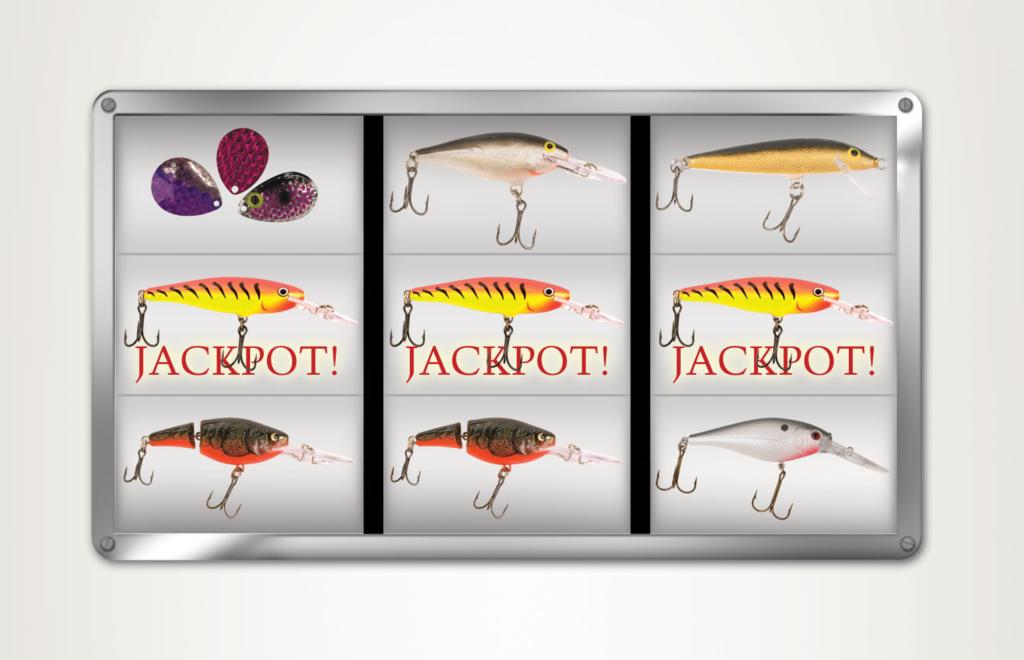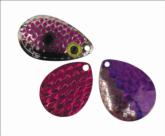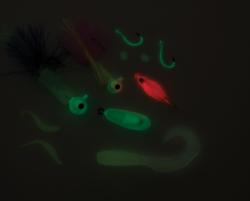Lucky seven
Seven must-have colors for every tackle box

We’ve all been there.
Standing in an aisle, surrounded by adjectives like “hot,” “bleeding,” “sparkle” and “tiger,” an angler’s eyes detect a foreign color. Instantly, his mind is triggered, bringing an entire lure inventory to the forefront of consciousness for analyzing. Like a supercomputer crunching data, his mind begins scrolling through boxes and boxes of lures in an attempt to identify the hue somewhere in the collection.
Depending on the size of the inventory, this can last anywhere from the blink of an eyelash to the verge of drooling. But after scouring every last lure, the search comes back empty. And with the excitement of a child, the angler snaps back to reality and utters every tackle shop owner’s favorite phrase, “Ooh, I don’t have that color.”
Despite all the high-tech sonar, scientific research and sophisticated gear, all it takes is a wall of shiny, colorful lures for an angler to revert back to a 4-year-old. Of course, that’s one of the beauties of fishing. Buying new toys in bright, shiny colors is often as fun as the sport itself.
The vast number of colors available to anglers only compounds the problem. Every lure color under, over and near the rainbow, including the color metallic rainbow, can be found in any decent tackle shop.
Bright colors. Natural colors. Dark colors. Shiny colors. Dull colors. Holographic colors. Trolling colors. Casting colors. Colors used during cold fronts in summer. Colors used in the morning only between 9:18 a.m. and 9:52 a.m. And just when anglers think they own them all, some new prism-colored, metallic-finish-with-glitter monstrosity hits the shelves labeled “this year’s hot, new color,” and they run out to buy it.
Now, that’s not to say having a favorite crankbait in 52 different colors doesn’t have its advantages. Walleyes are visual predators, meaning they rely primarily on their eyes to determine what they want to eat – exactly why color is so important.
Then there’s the body of water. For whatever reason, be it water clarity, forage or the way the planets line up, walleyes in certain bodies of water seem to prefer specific colors. Heading out on any of the Great Lakes without something purple is considered breaking the law in some Midwestern towns. Same goes for firetiger on the Mississippi River.
But for every fish caught on colors like red hot tiger, chartreuse purple shiner and monkey puke (scarily, a real color), there are just as many caught on plain old white, silver and brown.
So it begs the question: What colors do walleye anglers really need?
Considering the pros on the Walmart FLW Walleye Tour Presented by Berkley generally fall into the overkill category when it comes to colors, asking them to pick just a couple of favorites was like asking them which fingers they couldn’t do without. After some painful deliberation, they finally narrowed it  down to seven colors that, no matter the body of water, no angler should leave the boat ramp without.
down to seven colors that, no matter the body of water, no angler should leave the boat ramp without.
1. Crayfish
Like every other color, lure manufacturers have found a way to turn the simple crayfish into a Mardi Gras party favor. Along with the natural crayfish color, anglers have choices like chartreuse crayfish, green crayfish, red crayfish, phantom brown crayfish, crystal crawdad and brown mud craw, just to name a few.
But as fun as these variations can be, the closer to the natural color a lure looks, generally, the more fish like it.
“It’s really a universal color,” pro Chris Gilman said. “While it looks like a crayfish, that mixture of brown, gold and orange also looks like many other types of prey. When you look at a lot of baitfish, they’re not all silver. The crayfish color pattern can also mimic gobies, suckers, chubs or perch.
“The best thing about the color is it can be used anywhere. It’s my No. 1 river color, but I have success with it in all bodies of water.”
The Chisago City, Minn., native, who finished fourth in the 2008 tour standings, fishes mostly clear lakes and prefers a crayfish pattern with a dark brown back and a gold tint on the sides. But for anglers who more often fish stained waters or rivers, one with a bright orange belly or tint will stand out more.
 2. White
2. White
This may be the most anticlimactic color on the list. The power of white is no secret, considering fishermen have been using it since they were making hooks out of bone. And even after hundreds of years of falling for the color, walleyes still can’t get enough of it. Why?
“Because so much of what they eat is white,” said Coppertone pro Dustin Kjelden of Brookings, S.D.
It’s true. Smelt, ciscoes, tullibees, whitefish – they can all be imitated with the color white, making it a go-to color for Kjelden and many of his fellow tour pros. Plus, the stark-white color stands out in most water conditions.
“Obviously it works well in clear water,” Kjelden said. “But that white is still very visible in dingy water. The majority of the time, if I’m pulling something, it’s white.”
As for matching color to weather conditions, use flat white under cloudy conditions or murky water since it requires less light to stand out. But under sunny conditions and clear water, making a switch to pearl can add flash.
Oh, and remember those bodies of water where a certain color is a must? Well, don’t venture out onto any of the Missouri River reservoirs without a white crankbait.
 3. Chartreuse/firetiger
3. Chartreuse/firetiger
Whether it’s blades, beads, bodies or jigs, owning lures that look like they have radiation poisoning is a must.
Many pros’ boats glow at night with the amount of chartreuse they carry in them – that includes Kelly Klemm’s. The Wheaton, Minn., native uses chartreuse anytime he’s searching for a pattern, and he attributes a lot of his success on the tour to using the color to brighten up his lures – including his Walmart FLW Walleye Tour Presented by Berkley win on Lake Sharpe last May.
“It’s an all-around color that works in any body of water,” Klemm said. “It’s usually the first bait I’ll pull out when I’m trying to find fish. Then I fine-tune from there.
“Obviously the color is great in dirty water and rivers because it’s so bright. But I like it in clear water too because fish can see it from a long way off.”
Klemm uses a lot of chartreuse beads on his harnesses for that very reason. The glow thrown off by the color seems to be just the thing to get a walleye’s attention. The same goes for using a blade with a splash of chartreuse paint, or an all-chartreuse jig in front of a leech or minnow.
And don’t forget firetiger. When it comes to river fishing, this gaudy combination of chartreuse and black stripes on a crankbait is hard to beat.
 4. Gold and black,
4. Gold and black,
5. Silver and black
Two different colors, two different applications, similar thought processes behind both. For matching forage, silver with black; and gold with black are both hall-of-famers. But as great as these two colors are alone, they work better as a tag team.
“It’s all about the water color,” said Rick Franklin, the Bemidji, Minn., native who finished third in the 2008 tour standings. “I switch between the two depending on the type of water I’m fishing.”
When fishing bodies of water with a slight stain, like those in the northern tier of Minnesota, Franklin has noticed most of the forage flickers gold. Even if it appears silver out of the water, in the water it shines gold. Thus, Franklin uses gold and black to mimic what the walleyes see.
But for clearer waters, like those in the southern tier of Minnesota, the baitfish appear in the water the same as they do out of it – silver. And with a quick switch to the other member of this duo, silver and black, anglers will be back in business.
“Anglers shouldn’t only do this for crankbaits,” Franklin said. “I’ll use gold jigs in the stained water and plain lead in clearer water. The idea is simply to match the forage as close as possible.”
 6. Purple
6. Purple
The idea of throwing a purple lure may infringe on some mens’ manliness. In fact, the stigma surrounding the color probably got the first angler to throw it laughed off the lake. Luckily, whoever that was had thick skin, because their purple idea is now a staple of many big-water tackle boxes.
But while many of the other colors are relatively universal, this one is a little more specific. In general, two things are necessary for this color to be fully effective: clear water and low-light conditions.
“Walleyes don’t key on the color, they’re picking out the shadow the color throws off,” said Bill Shimota of Lonsdale, Minn. “Under cloudy conditions the color can really stand out. But clear water is key so the fish can see it. I do use it in dirtier water, but very rarely.”
On bodies of water like the Great Lakes, Shimota likes to combine purple with metallic colors, such as gold, silver or copper, on his crankbaits and spinners. The idea is to give his lures a little flash, similar to the alewives that are abundant in those waters.
“Alewives have an iridescent silver and gold tint to them,” Shimota said. “So I like to combine purple and gold on my spinners to mimic that. It’s the same thing with chrome and purple on crankbaits.”
7. Glow
Even the savviest walleye angler may scratch his head at this one. But believe it or not, glow colors have been a secret of many of the top pros for years. Such a secret, in fact, that Tommy Skarlis of  Waukon, Iowa, was very reluctant to give them up. Luckily, he’s honest.
Waukon, Iowa, was very reluctant to give them up. Luckily, he’s honest.
“Some of the other pros and I have done extremely well on glow colors,” Skarlis said. “In murky water or water with current, the fish seem to really respond to glow. I’ve started to do better with them in clear water too, and also at night and ice fishing.”
When talking about glow colors, the image that probably comes to mind for many anglers is the old off-white color that glows chartreuse. But companies such as Lindy and Berkley have taken glow to a new spectrum with nearly a dozen different illuminating colors. So which ones should an angler have?
“Red glow and blue glow have been the two best for me,” Skarlis said.
The key to these colors is not having the lure glow too much. At night, only shine enough light on the lure to have a dull glow. And during the day, the ambient sunlight is usually enough to make it light up. It may be a subtle thing, but many other walleye anglers won’t be throwing these colors, making them perfect for rounding out a tackle box.
So go ahead. Buy that iridescent-tan crankbait with the turquoise stripes and magenta sparkles. There probably will come a day when that will be the hot color. But for anglers who just want to feel confident knowing they have all the bases covered, they should consider the advice of these pros.
But just to be clear, it’s still OK to drool over the wall of pretty colors.